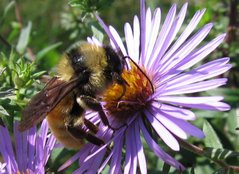
 Algonquin Park, Bat Lake
Algonquin Park, Bat Lake25 June, 2006
This was growing beside the path in some moss. The roots were anchored to the rootlet of a coniferous tree. The cap was 7.5 cm. The stem was 8 cm. The flesh inside the cap is white. The brown skin peels off easily to reveal the white flesh.
Identifying almost any mushroom can be very difficult. In this case one look at the pore surface tells you that it is a Bolete. The two subgroups, Boletus and Tylopilus usually have stalks that are covered with a network of veins (i.e. are reticulate). In the subgroup Leccinum the stalk is always Scabrous. In the subgroup Suillus the stalk frequently has these speckled, glabrous, dots. All of this I determined from looking at "Mushrooms Demystified" by David Arora. I then went to the key in "Mushrooms of Northeastern North America" by Bessette, Bessette, and Fischer and looked at the key for Suillus. This guide is my first choice because it deals only with mushrooms of the Northeastern area. The description and picture of S. granulatus best met the mushroom that I was looking at.

No comments:
Post a Comment